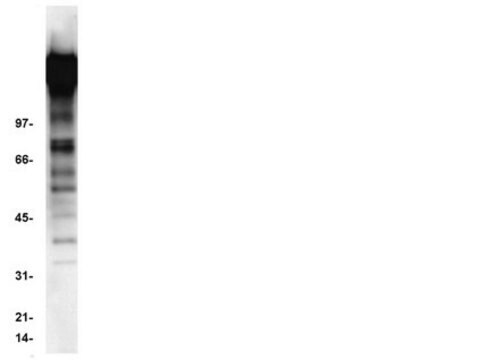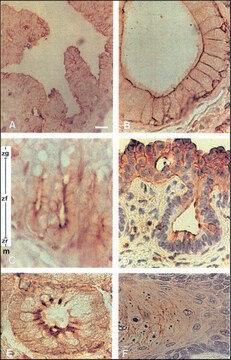16-638
4G10® Platinum, Anti-Phosphotyrosine Antibody, Agarose Conjugate
clone 4G10®, Upstate®, from mouse
Sign Into View Organizational & Contract Pricing
All Photos(1)
About This Item
UNSPSC Code:
12352203
eCl@ss:
32160702
NACRES:
NA.41
Recommended Products
biological source
mouse
Quality Level
antibody product type
primary antibodies
clone
4G10®, monoclonal
species reactivity (predicted by homology)
all
manufacturer/tradename
Upstate®
technique(s)
immunoprecipitation (IP): suitable
isotype
IgG2bκ
shipped in
wet ice
target post-translational modification
phosphorylation (pTyr)
Gene Information
human ... PID1(55022)
General description
The development of the anti-phosphotyrosine, clone 4G10 in 1989 was a monumental discovery for researchers. 4G10 was the first and best single monoclonal antibody for the detection tyrosine phosphorylation. 4G10 is well known for its sensitivity and its ability to detect multiple tyrosine phosphorylations on numerous substrates. It has been validated by thousands of scientific and medical researchers in virtually every application and tyrosine target over the past 2 decades. Now Millipore has made the best even better with 4G10 Platinum. We pooled 4G10 with the next most highly regarded anti-phosphotyrosine, clone PY20, to make 4G10 Platinum. PY20 itself is a very poor substitute for 4G10, but its additive effect allow for a greater level of detection on more substrates that even 4G10 alone is capable.
Immunogen
The immunogen for 4G10 was phospho-tyramine coupled to KLH, while the immunogen for PY20 was phosphotyrosine conjugated to a carrier protein.
Application
4G10 Platinum, Anti-Phosphotyrosine, Agarose Conjugate detects levels of Phosphotyrosine proteins & has been published & validated for use in IP.
Features and Benefits
Format: Gel Immobilized
Quality
Immunoprecipitation:
Twenty μl of 50% slurry of this reagent (10 μl packed beads) was used to immunoprecipitate tyrosine-phosphorylated proteins from 250 μg PDGF-stimulated NIH3T3 cell lysate or EGF-stimulated A431 cell lysate.
Twenty μl of 50% slurry of this reagent (10 μl packed beads) was used to immunoprecipitate tyrosine-phosphorylated proteins from 250 μg PDGF-stimulated NIH3T3 cell lysate or EGF-stimulated A431 cell lysate.
Target description
Dependent upon the molecular weight of the Tyrosine-phosphorylated protein
Physical form
Supplied as a 50% slurry of a proprietary mixture of agarose conjugated, protein G purified mouse monoclonal 4G10 (IgG2bκ) and protein A purified PY20 (IgG2b) in PBS, pH 7.4 with 0.05% sodium azide.
protein G purified mouse monoclonal 4G10 (IgG2bκ) and protein A purified PY20 (IgG2b)
Storage and Stability
Stable for 6 months at 2-8°C from date of shipment. For maximum recovery of product, centrifuge the vial prior to removing the cap.
NOTE: DO NOT FREEZE.
NOTE: DO NOT FREEZE.
Legal Information
4G10 is a registered trademark of Upstate Group, Inc.
UPSTATE is a registered trademark of Merck KGaA, Darmstadt, Germany
Not finding the right product?
Try our Product Selector Tool.
Storage Class
10 - Combustible liquids
wgk_germany
WGK 2
Certificates of Analysis (COA)
Search for Certificates of Analysis (COA) by entering the products Lot/Batch Number. Lot and Batch Numbers can be found on a product’s label following the words ‘Lot’ or ‘Batch’.
Already Own This Product?
Find documentation for the products that you have recently purchased in the Document Library.
S Ruff-Jamison et al.
The Journal of biological chemistry, 266(10), 6607-6613 (1991-04-15)
Phosphotyrosine and similar analogs have been used to elicit antibodies that have found widespread use in the study of cellular tyrosine phosphorylation. In order to better understand the anti-phosphotyrosine immune response and to elucidate the details of the specific association
Rachit Badolia et al.
The Journal of biological chemistry, 292(35), 14516-14531 (2017-07-15)
Platelets play a key role in the physiological hemostasis or pathological process of thrombosis. Rhodocytin, an agonist of the C-type lectin-like receptor-2 (CLEC-2), elicits powerful platelet activation signals in conjunction with Src family kinases (SFKs), spleen tyrosine kinase (Syk), and
Claudia Voena et al.
Cancer research, 67(9), 4278-4286 (2007-05-08)
Anaplastic large cell lymphomas (ALCL) are mainly characterized by the reciprocal translocation t(2;5)(p23;q35) that involves the anaplastic lymphoma kinase (ALK) gene and generates the fusion protein NPM-ALK with intrinsic tyrosine kinase activity. NPM-ALK triggers several signaling cascades, leading to increased
Philippe Foubert et al.
The Journal of clinical investigation, 117(6), 1527-1537 (2007-05-19)
Endothelial progenitor cell (EPC) transplantation has beneficial effects for therapeutic neovascularization; however, only a small proportion of injected cells home to the lesion and incorporate into the neocapillaries. Consequently, this type of cell therapy requires substantial improvement to be of
The carboxyl terminus controls ligand-dependent activation of VEGFR-2 and its signaling
Meyer, R. D., et al
The Journal of Biological Chemistry, 279, 735-742 (2004)
Our team of scientists has experience in all areas of research including Life Science, Material Science, Chemical Synthesis, Chromatography, Analytical and many others.
Contact Technical Service







